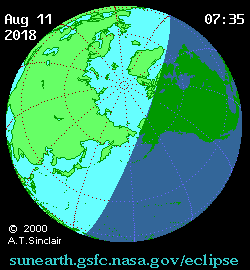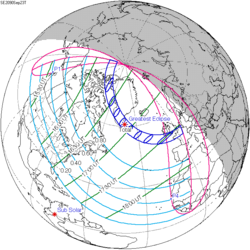Top Qs
Timeline
Chat
Perspective
Solar eclipse of August 11, 2018
21st-century partial solar eclipse From Wikipedia, the free encyclopedia
Remove ads
A partial solar eclipse occurred at the Moon's ascending node of orbit on Saturday, August 11, 2018,[1][2][3] with a magnitude of 0.7368. A solar eclipse occurs when the Moon passes between Earth and the Sun, thereby totally or partly obscuring the image of the Sun for a viewer on Earth. A partial solar eclipse occurs in the polar regions of the Earth when the center of the Moon's shadow misses the Earth.
The eclipse was visible in northeastern Canada, Greenland, Northern Europe, and northern Asia.
Remove ads
Visibility

The maximal phase of the partial eclipse was recorded in the East Siberian Sea, near Wrangel Island.
The eclipse was observed in Canada, Greenland, Scotland, most of the Nordic countries (Iceland, Norway, Sweden, Finland), Estonia, Latvia, practically throughout Russia (except for places southwest of the line roughly passing through Pskov, Moscow and Penza, and the most eastern places of the Far East), in Kazakhstan, Kyrgyzstan, Mongolia and China. During sunset, the eclipse was observed in North and South Korea.
Remove ads
Eclipse timing
Places experiencing partial eclipse
Remove ads
Gallery
- Moscow, Russia, 9:40 UTC
- Baley, Russia, 10:24 UTC
Eclipse details
Shown below are two tables displaying details about this particular solar eclipse. The first table outlines times at which the Moon's penumbra or umbra attains the specific parameter, and the second table describes various other parameters pertaining to this eclipse.[4]
Remove ads
Eclipse season
This eclipse is part of an eclipse season, a period, roughly every six months, when eclipses occur. Only two (or occasionally three) eclipse seasons occur each year, and each season lasts about 35 days and repeats just short of six months (173 days) later; thus two full eclipse seasons always occur each year. Either two or three eclipses happen each eclipse season. In the sequence below, each eclipse is separated by a fortnight. The first and last eclipse in this sequence is separated by one synodic month.
Remove ads
Related eclipses
Eclipses in 2018
- A total lunar eclipse on January 31.
- A partial solar eclipse on February 15.
- A partial solar eclipse on July 13.
- A total lunar eclipse on July 27.
- A partial solar eclipse on August 11.
Metonic
- Preceded by: Solar eclipse of October 23, 2014
Tzolkinex
- Preceded by: Solar eclipse of July 1, 2011
- Followed by: Solar eclipse of September 21, 2025
Half-Saros
- Preceded by: Lunar eclipse of August 6, 2009
- Followed by: Lunar eclipse of August 17, 2027
Tritos
- Preceded by: Solar eclipse of September 11, 2007
- Followed by: Solar eclipse of July 11, 2029
Solar Saros 155
- Preceded by: Solar eclipse of July 31, 2000
- Followed by: Solar eclipse of August 21, 2036
Inex
- Preceded by: Solar eclipse of August 31, 1989
- Followed by: Solar eclipse of July 22, 2047
Triad
- Preceded by: Solar eclipse of October 11, 1931
- Followed by: Solar eclipse of June 12, 2105
Solar eclipses of 2015–2018
This eclipse is a member of a semester series. An eclipse in a semester series of solar eclipses repeats approximately every 177 days and 4 hours (a semester) at alternating nodes of the Moon's orbit.[5]
The partial solar eclipse on July 13, 2018 occurs in the next lunar year eclipse set.
Saros 155
This eclipse is a part of Saros series 155, repeating every 18 years, 11 days, and containing 71 events. The series started with a partial solar eclipse on June 17, 1928. It contains total eclipses from September 12, 2072 through August 30, 2649; hybrid eclipses from September 10, 2667 through October 2, 2703; and annular eclipses from October 13, 2721 through May 8, 3064. The series ends at member 71 as a partial eclipse on July 24, 3190. Its eclipses are tabulated in three columns; every third eclipse in the same column is one exeligmos apart, so they all cast shadows over approximately the same parts of the Earth.
The longest duration of totality will be produced by member 14 at 4 minutes, 5 seconds on November 6, 2162, and the longest duration of annularity will be produced by member 63 at 5 minutes, 31 seconds on April 28, 3046. All eclipses in this series occur at the Moon’s ascending node of orbit.[6]
Metonic series
The metonic series repeats eclipses every 19 years (6939.69 days), lasting about 5 cycles. Eclipses occur in nearly the same calendar date. In addition, the octon subseries repeats 1/5 of that or every 3.8 years (1387.94 days). All eclipses in this table occur at the Moon's ascending node.
Tritos series
This eclipse is a part of a tritos cycle, repeating at alternating nodes every 135 synodic months (≈ 3986.63 days, or 11 years minus 1 month). Their appearance and longitude are irregular due to a lack of synchronization with the anomalistic month (period of perigee), but groupings of 3 tritos cycles (≈ 33 years minus 3 months) come close (≈ 434.044 anomalistic months), so eclipses are similar in these groupings.
The partial solar eclipse on November 4, 2116 (part of Saros 164) is also a part of this series but is not included in the table below.
Inex series
This eclipse is a part of the long period inex cycle, repeating at alternating nodes, every 358 synodic months (≈ 10,571.95 days, or 29 years minus 20 days). Their appearance and longitude are irregular due to a lack of synchronization with the anomalistic month (period of perigee). However, groupings of 3 inex cycles (≈ 87 years minus 2 months) comes close (≈ 1,151.02 anomalistic months), so eclipses are similar in these groupings.
Remove ads
External links
Wikimedia Commons has media related to Solar eclipse of 2018 August 11.
- Earth visibility chart and eclipse statistics Eclipse Predictions by Fred Espenak, NASA/GSFC
- Kudryashova, Natalia (August 14, 2018). "Солнечное затмение 11 августа 2018 года на фото: Каким видели Солнце в разных уголках Земли" [Solar eclipse of August 11, 2018: How the sun was seen in different parts of the Earth] (in Russian). Retrieved 2019-01-02.
Remove ads
References
Wikiwand - on
Seamless Wikipedia browsing. On steroids.
Remove ads



























































































